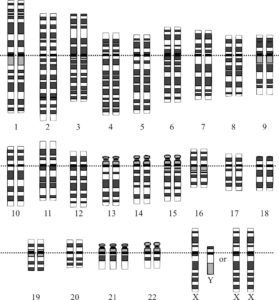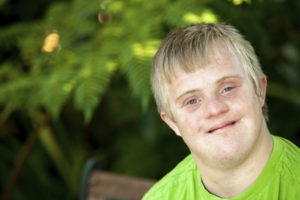Most of us are born with 23 pairs of chromosomes, for a total of 46. These chromosomes include DNA and other genetic building blocks. Some people, however, are born with a trisomy condition, that is, an extra chromosome. Trisomy can lead to a variety of problems, including physical and intellectual and developmental disabilities. March is Trisomy Awareness Month: the three most common trisomy conditions are as follows:
-

Karyotype for trisomy Down syndrome: Notice the three copies of chromosome 21. Courtesy: National Human Genome Research Institute – Human Genome Project
Trisomy 21. Most of us know this condition as Down syndrome, named after the British physician John, along with the familiar physical characteristics and facial features. Children with Down syndrome are at increased risk of cardiac (heart), endocrine (thyroid), gastrointestinal (digestive), auditory (hearing), and periodontal (gum) conditions. Many people who work among individuals with Down syndrome note their general happiness and positive outlook on life. However, these people may experience depression and anxiety in early adulthood and develop Alzheimer’s later in life.
- Trisomy 18. Also known as Edwards syndrome, this is the second most common trisomy condition. Children born with Trisomy have severe intellectual disabilities that accompany microcephaly, an unusually small head (along with a small lower jaw). Many other internal and external physical anomalies are present as well. Half of infants die before their first week, and only 1 percent survive beyond their first year.
- Trisomy 13. At times referred to as Patau syndrome, children with trisomy 13 have severe intellectual disabilities. As with trisomy 18, most infants born with trisomy have severe medical conditions and die very early in life and only 5 to 10 percent live beyond their first year.
Though trisomies 13, 18, and 21 are the most common, trisomy can occur with any chromosome. Most of those genetic anomalies, however, are not viable and result in miscarriage.

A teenage girl with Down syndrome uses a laptop.

A happy boy with Down syndrome
Also Worth Knowing…
- The risk of having a baby with a trisomy condition increases with the age of the mother, especially after her early 30s.
- Statistically, the incidence of trisomy 21 (Down syndrome) is about 1 in 1,000 live births; for trisomy 18, this is about 1 in 5,000 live births, and for trisomy 13, about 1 in 10,000 to 21,700 live births (the median figure being 1 in 16,000 live births).
- However, there are no precise figures on how common Down syndrome and other trisomy conditions are, as some parents elect not to carry a fetus that has been diagnosed as such to term. Such abortions are naturally a highly emotional issue, with strong viewpoints even within each of the Pro Choice, Pro Life, and disability advocacy communities.

